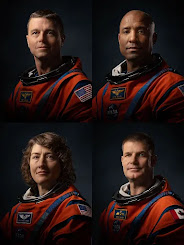What is ARTEMIS?
The Artemis program is NASA's initiative to return humans to the Moon and create a lasting presence there. Named after the Greek goddess Artemis, Apollo's twin sister, Artemis aims to land the first woman and the next man on the lunar surface. This program marks significant advancement in space exploration, continuing the legacy of the Apollo missions.
Why ARTEMIS?
The Artemis program builds on the Apollo missions' achievements. While Apollo showed that humans could land on the Moon, Artemis focuses on exploring new areas—especially the South Pole—where ice can provide water and fuel. This ice enables longer stays on the Moon. Artemis will also test new technologies for future Mars missions, create jobs through a lunar economy, and inspire young explorers.
Mission Objective:
To return humans to the Moon and establish a sustainable presence, paving the way for future missions to Mars.
Main Components:
-
Space Launch System (SLS) – a powerful new rocket.
-
Orion spacecraft – built to carry astronauts beyond low Earth orbit.
-
Lunar Gateway – a small space station that will orbit the Moon.
Planned Missions:
-
Artemis I: Uncrewed test flight.
-
Artemis II: First crewed mission orbiting the Moon.
-
Artemis III: A mission to land astronauts on the lunar surface.
Partnerships:
The success of Artemis depends on international cooperation, including contributions from the European Space Agency (ESA) and private companies like SpaceX.
-
Reid Wiseman: Commander
-
Victor Glover: Pilot
-
Christina Koch: Mission Specialist
-
Jeremy Hansen: Mission Specialist (Canadian Space Agency)
Artemis I Mission:
-
Uncrewed mission
-
Purpose: To test the SLS rocket and Orion spacecraft
-
Objective: Demonstrate capabilities in preparation for crewed Moon and Mars missions
Why was Artemis II delayed by two years?
NASA delayed Artemis II due to safety concerns. During Artemis I, uneven erosion of Orion’s heat shield was observed upon re-entry, requiring redesign. Additionally, issues with the abort system’s electronics and mechanics needed to be resolved. NASA prioritized astronaut safety, leading to the delay.
Lunar Gateway
The Gateway is a planned space station orbiting the Moon, part of the Artemis program. It will support long-term human presence and research on the Moon. It also allows global collaboration, with contributions from Europe, Japan, and other countries.
The Gateway will evolve over time with modules added for various missions. It will also help prepare for Mars exploration by allowing astronauts to live and work in space for extended periods. This project highlights international cooperation and human advancement in space.
Mars Missions
Artemis uses the Moon as a stepping stone for Mars missions. It allows NASA to test technologies and build experience for long-duration spaceflight. Lessons from Artemis I—like heat shield redesigns—will help prepare for the challenges of sending humans to Mars.
Conclusion:
The Artemis program is a bold step in space exploration. With teamwork between nations and industries, Artemis opens doors to new discoveries and inspires the next generation. The journey to the Moon—and eventually Mars—is just beginning, and the possibilities are limitless.
Thank you for reading.
Jr. Scientist Aaryahee Trivedi




